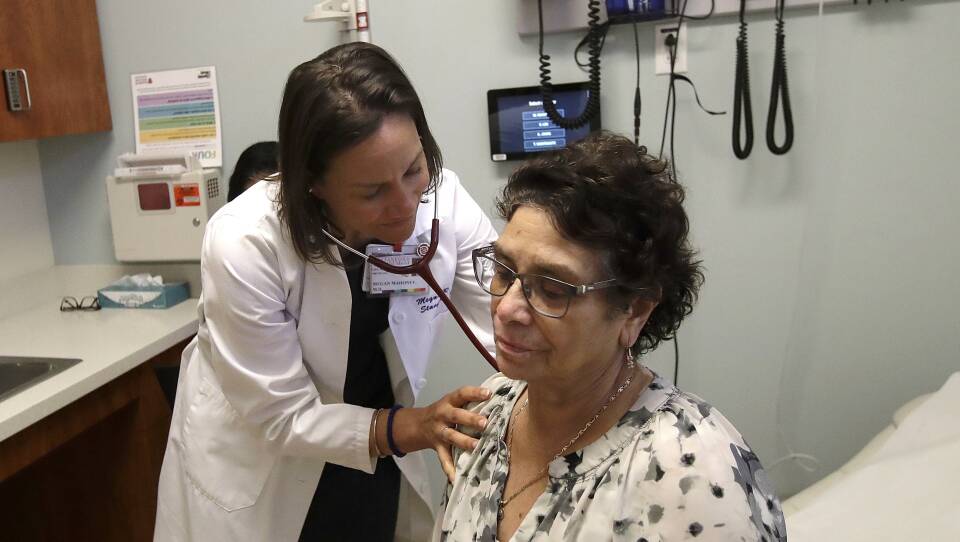As a task force of health policy experts and providers explore strategies to boost primary care spending in Massachusetts, Rhode Island’s former health insurance commissioner advised members to focus on enforcement and accountability mechanisms -- rather than “aspirational” targets.
“Targets are just not sufficient. That’s the bottom line,” said Christopher Koller, who is now president of the Milbank Memorial Fund that aims to improve population health and health equity by working with state health policy leaders.
Koller shared primary care reform lessons learned from other states, including Rhode Island and Oregon, with the Primary Care Access, Delivery, and Payment Task Force last week. The panel, created through a 2025 hospital and market oversight law, is tasked with developing recommendations to set a primary care target “for private and public health care payers that reflects the cost to deliver evidence-based, equitable and culturally competent primary care.”
The governor and Senate president have eyed primary care reforms to bolster access to the kind of preventative care that can also help hold down health care spending in more expensive settings, like the emergency room.
In Massachusetts in 2023, primary care accounted for 6.7% of commercial insurers’ total spending, marking a slight drop from 6.9% in 2022, according to a new state dashboard. Of MassHealth’s total spending in 2023, 7.5% was on primary care, compared to 5.3% in 2022.
Koller suggested the task force can leverage tools already in place to revamp spending, including turning to the health care cost growth benchmark set by the Health Policy Commission. He also highlighted monitoring and enforcement capabilities of the HPC and the Center for Health Information and Analysis.
“When you talk about primary care spend, I think that means getting commercial insurance, the Connector, and the GIC aligned and working in the same direction,” Koller said.
Koller encouraged the panel to “think about enforcement,” as well as consequences and penalties.
Dr. Barbara Spivak, a task force member and former president of the Massachusetts Medical Society, noted the majority of primary care service here is delivered through academic medical centers and for-profit organizations.
“Their goals are very different than the goals of primary care,” Spivak said. “In many ways, they are looking for expensive procedures that will get highly reimbursed.”
Spivak said some policymakers have mulled over removing primary care from those systems and creating a “primary care-organized group,” though that model has not been implemented in the United States. Koller advised Spivak to think “incrementally” and potentially embrace MassHealth’s model of fixed monthly rates per member for primary care services.
“I like Barbara’s idea of having a centralized primary care base for the entire state run by some other organization and all of us getting out of it. I just don’t see it ever happening,” task force member Dr. Eric Dickson, CEO of UMass Memorial Health, chimed in.
“There’s six health care systems in the state that control the vast majority of health care,” Dickson continued. “Two of them control more than 50%, and they’re not disproportionate share providers. The other four have almost twice as much Medicaid as those two. I’m not picking on anybody or saying some are bad and some are good, but the solution is going to be very different for the four safety net health care systems.”
Koller said more than 20 states in the last seven years have established “aspirational targets” to increase primary care spending rates.
He pointed to California, which recently set a 15% benchmark for primary care spending, measured across total medical spending for all payers, by 2034. That would more than double historical spending trends of about 7% spending on primary care.
“Looking at 20 states that have done this, aspirational targets do not work,” Koller said. “None of them resulted in an increase in primary care spending as a result, or even a move to more aggressive policy requirements.”
In another approach, states can require insurers to increase or redistribute spending on primary care, though that strategy has also led to “partial victories at best,” Koller acknowledged.
In 2010 as part of the rate review process, Rhode Island required commercial insurers to increase the share of dollars flowing into primary care by a percentage point annually. But the state relied on self-reporting from insurers and used a “crude” definition of primary care,“ Koller said.
”The regs were rewritten just this year, with a tighter definition of primary care, a narrowing of allowed expenses, and an expanded denominator,“ Koller said, referring to overall health care spending. ”The net effect is going to put more dollars in, but only for the commercially insured piece, which is only 35 to 40% in Rhode Island of the employer insurance market. It’s a small piece of it.“
Meanwhile, Koller said that Oregon acted a ”little more aggressively“ than Rhode Island in 2016 by putting spending levels in statute for Medicaid, Medicare, commercial insurers and public employee plans. Still, the enforcement mechanism was unclear, and the ultimate performance of different insurers saw ”enormous variation,“ Koller said.
At least twice during his time in office, Gov. Charlie Baker unsuccessfully pushed for legislation that would have required providers and health insurers to boost spending on behavioral health and primary care services by 30% over three years, while keeping within the state’s health care cost growth benchmark. That likely would have required the industry to cut spending in other areas.
Massachusetts’s primary care task force faces a Sept. 15 deadline for its first report, with additional recommendations due by Dec. 15. The full panel meets next on July 22.





